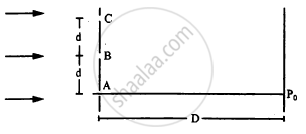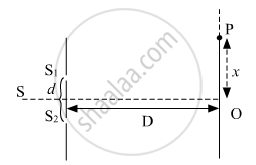Advertisements
Advertisements
प्रश्न
A monochromatic ray of light falls on a regular prism. What is the relation between the angle of incidence and angle of emergence in the case of minimum deviation?
उत्तर
The angle of incidence = i
The angle of emergence = e
Angle of refracting surface (r) angle of prism = A
The angle of minimum deviation = `delta_m`
`i + e = A + delta_m`
APPEARS IN
संबंधित प्रश्न
What kind of fringes do you expect to observe if white light is used instead of monochromatic light?
State the essential conditions for diffraction of light ?
If a monochromatic source of light is replaced by white light, what change would you observe in the diffraction pattern?
The following figure shows three equidistant slits being illuminated by a monochromatic parallel beam of light. Let \[B P_0 - A P_0 = \lambda/3\text{ and }D > > \lambda.\] (a) Show that in this case \[d = \sqrt{2\lambda D/3}.\] (b) Show that the intensity at P0 is three times the intensity due to any of the three slits individually.

"Monochromatic light should be used to produce pure spectrum". Comment on this statement.
Monochromatic fight of wavelength 198 nm is incident on the surface of a metallic cathode whose work function is 2.5 eV How much potential difference must be applied between the cathode and the anode of a photocell to just stop the photocurrent from flowing?
(a) Can the interference pattern be produced by two independent monochromatic sources of light? Explain.
(b) The intensity at the central maximum (O) in Young's double-slit experimental set-up shown in the figure is IO. If the distance OP equals one-third of the fringe width of the pattern, show that the intensity at point P, would `"I"_°/4`

(c) In Young's double-slit experiment, the slits are separated by 0⋅5 mm and the screen is placed 1⋅0 m away from the slit. It is found that the 5th bright fringe is at a distance of 4⋅13 mm from the 2nd dark fringe. Find the wavelength of light used.
A monochromatic ray of light falls on a regular prism under minimum deviation condition. What is the relation between angle of incidence and angle of emergence?
For constructive interference to take place between two monochromatic light waves of wavelength λ, the path difference should be ______.
Monochromatic light of wavelength 396 nm is incident on the surface of a metal whose work function is 1.125 eV. Calculate:
- the energy of an incident photon in eV.
- the maximum kinetic energy of photoelectrons in eV.
